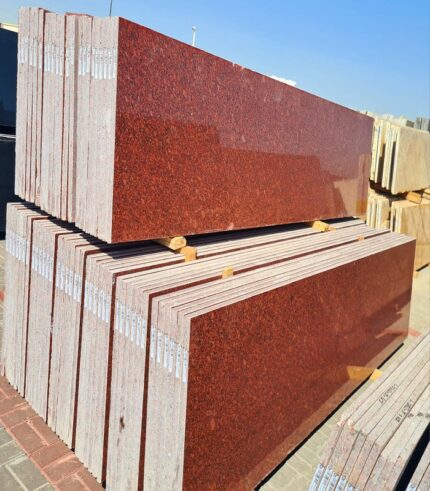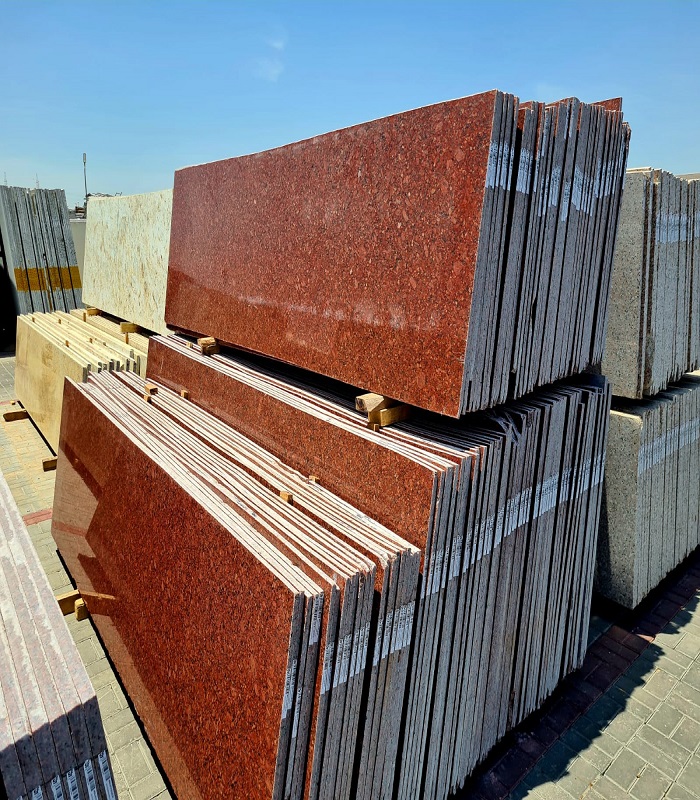Imperial Red Granite is a beautiful and popular natural stone that is quarried from the Rajasthan region of India. It is known for its rich, deep red color with black and gray flecks throughout the stone. The granite is formed by the slow cooling and solidification of magma beneath the Earth’s surface, which results in a durable and dense material that is resistant to heat, scratches, and stains.
This Granite is a versatile stone that can be used for a wide variety of applications, including flooring, countertops, walls, and exterior cladding. Its striking color and pattern make it a popular choice for both commercial and residential projects.
The stone has a medium to coarse grain texture with a polished, honed, or leathered finish. The polished finish provides a shiny and reflective surface, while the honed finish offers a more matte and smooth appearance. The leathered finish has a textured, slightly rough surface that is great for adding a natural and rustic feel to a space.
It is also known for its durability and longevity. With proper maintenance and care, it can last for decades without showing any signs of wear and tear. It is a low-maintenance material that only requires regular cleaning with a mild soap and water solution.
Overall, Imperial Red Granite is a stunning natural stone that can add warmth and elegance to any space. Its unique color and pattern make it a standout choice for those looking for a bold and beautiful material for their project.
Visit our Store Now!
Technical Specifications for Imperial Red Granite from Rajasthan, India:
- Composition: It is primarily composed of quartz, feldspar, and mica minerals. The red color of the stone comes from the presence of iron oxide minerals.
- Origin: It is quarried from the Aravalli Mountain Range in Rajasthan, India. Rajasthan is known for producing high-quality natural stones, including granite, marble, sandstone, and slate.
- Applications: This granite can be used for a variety of indoor and outdoor applications, such as flooring, countertops, wall cladding, fireplaces, and monuments.
- Finish: Besides the polished, honed, and leathered finishes, Imperial Red Granite is also available in a flamed finish, which creates a rough, textured surface that is slip-resistant and ideal for outdoor spaces.
- Cost: The cost of Imperial Red Granite can vary depending on the size of the project and the quality of the stone. However, compared to other exotic granites, it is generally considered a moderately priced material.
- Maintenance: To keep the stone looking its best, it is recommended to seal it regularly and avoid harsh chemicals that can damage the surface. With proper care, the stone can last for generations.
- Sustainability: The quarrying and processing of natural stone can have environmental impacts, but efforts are being made to reduce the carbon footprint of the industry. Many quarries have implemented sustainable practices, such as water recycling, energy-efficient machinery, and reforestation. Additionally, granite is a natural and recyclable material that does not emit harmful VOCs.
- Density: The density of it is typically around 2,600-2,700 kg/m³.
- Compressive strength: The compressive strength of Red Granite is typically around 180-220 MPa. This means that it can withstand a high amount of pressure without breaking or cracking.
- Water absorption: The water absorption rate of Imperial Red Granite is typically less than 0.5%. This indicates that it is a very dense and non-porous material that is highly resistant to water damage and staining.
- Porosity: The porosity of Imperial Red Granite is generally low, which makes it resistant to weathering, erosion, and chemical damage.
- Flexural strength: The flexural strength of Imperial Red Granite is typically around 12-18 MPa. This means that it can withstand a certain amount of bending without cracking or breaking.
- Frost resistance: It is highly frost-resistant, which means that it can withstand freezing temperatures and the expansion and contraction of water without damage.
- Slip resistance: Depending on the finish, Imperial Red Granite can have varying levels of slip resistance. The leathered and flamed finishes are more slip-resistant than the polished finish.
These technical specifications are important to consider when choosing Imperial Red Granite for a specific application. They indicate the stone’s strength, durability, and resistance to various factors that can affect its appearance and performance over time.


